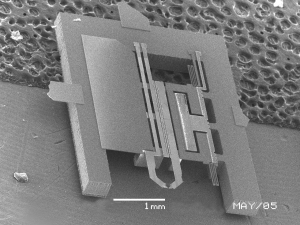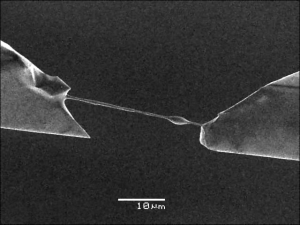 Back Back
Integration of Nano Grippers and Microactuators with Ultimate Accuracy towards Direct DNA Manipulation and Characterization
( Former project )C. Yamahata, D. Collard, H. Fujita
Get the pdf file  Keywords: nanotweezers, DNA, silicon |
|
|
|
DNA trapping on fixed twin probe
|
|
|
|

This research project aims to contribute to the first demonstration of the direct molecule manipulation and characterization with a MEMS actuator, DNA strand being the targeted molecule.
The molecule direct manipulation, characterization and positioning by integrated MEMS actuator have not been demonstrated yet, one of the major reason being the lack of an integrated MEMS actuator with enough accuracy. This capability has the potential to bring a drastic change in bio technology by replacing statistical method over a huge number of molecules in a test tube or even a microfluidic system by direct assay at the single molecule level.
 Electrostatically actuated nanotweezers in silicon for λ-DNA manipulation. (designed at Kagawa University, laboratory of Prof. Gen Hashiguchi) Electrostatically actuated nanotweezers in silicon for λ-DNA manipulation. (designed at Kagawa University, laboratory of Prof. Gen Hashiguchi)In order to demonstrate direct DNA manipulation and characterization with MEMS actuator, the research plan has to tackle two challenging subjects:
The first one concerns the MEMS actuator itself that has to achieve, at least, nm range stability and accuracy with closed-loop control. These performances have not been demonstrated yet for any published integrated device.
The second subject deals with the direct manipulation and characterization of bio molecules (DNA strand). Intensive experimentations are demanded to improve our knowledge |
|
on the interface between biological and inorganic systems at the nanoscale range.
These two subjects will be investigated in parallel in order to converge to an optimized experimental set up that make possible the direct bio molecular manipulation and characterization. Hopefully, the collection of numerous data is the ultimate goal of this project thanks to the highly parallel procedure provided by the integrated MEMS technology.
On the base of the nano-actuation capabilities previously developed, DNA tweezers will be completed by adding molecule manipulation and characterization functionalities.
 A bundle of DNA observed under SEM microscope. The photograph of the probes was obtained after taking up the nanotweezers from a solution of λ-DNA (16 ┬Ám long strand) [1]. A bundle of DNA observed under SEM microscope. The photograph of the probes was obtained after taking up the nanotweezers from a solution of λ-DNA (16 ┬Ám long strand) [1]. Poster presented at MMB 2006.
>> Slide show (powerpoint)
Presentation given at Transducers 2007.
>> Slide show (powerpoint)
|
|
 Back Back
Last modified: October 16th, 2008
|